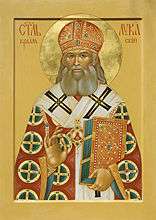Luka (Voyno-Yasenetsky)
Luke of Simferopol [1][2] (Luke, Russian: Архиепи́скоп Лука́, born Valentin Felixovich Voyno-Yasenetsky, Russian: Валенти́н Фе́ликсович Во́йно-Ясене́цкий; April 27 or May 9, 1877 in Kerch – June 11, 1961, Simferopol), also known as Saint Luke the Surgeon, was an outstanding surgeon, the founder of purulent surgery, a spiritual writer, a bishop of the Russian Orthodox Church, and archbishop of Simferopol and the Crimea from May 1946. He was a laureate of the Stalin Prize in medicine in 1946.
Luke the Surgeon | |
|---|---|
.jpg) Photograph of Archbishop Luka Voyno-Yasenetsky | |
| Archbishop, Confessor, Surgeon and Wonderworker | |
| Born | Valentin Felixovich Voyno-Yasenetsky 9 May 1877 Kerch, Taurida Governorate, Russian Empire |
| Died | 11 June 1961 (aged 84) Simferopol, Soviet Union |
| Venerated in | Eastern Orthodoxy |
| Canonized | 25 May 1996, Sarov Monastery by Holy Governing Synod, Russian Orthodox Church |
| Major shrine | Holy Trinity Cathedral, Simferopol, Russia |
| Feast | May 29 June 11 (Repose) |
| Attributes | Wearing bishop's vestment, pectoral cross and engolpion worn about his neck, miter and crozier. |
| Patronage | Doctors Nurses Pharmacies Physicians Surgeons Scientists |
His most important work in medicine is Sketches of Purulent Surgery (1934).[3] This is still a reference book and a manual for surgeons. As a noticeable religious figure, he was subjected to political repressions and spent 11 years in internal exile. Luke's mother was Orthodox and his father was Catholic, and according to his memoirs, he did not receive a religious upbringing from his family. When he left school the principal gave him a copy of the New Testament, and it was by a careful study of this that he came to know the teachings of Christ.
Glorification
He was canonized by the Russian Orthodox Church on May 25, 1996. His feast day is May 29/June 11 (Julian [Old] Calendar/Revised Julian [New] Calendar). On March 17, 1996, Luke's remains were disinterred, with many thousands of people attending the ceremony. It is said that an indescribable aroma arose from his relics, while his heart was discovered incorrupt , a testament to the great love he bore towards Christ and his fellow men. Three days later on March 20, 1996, his relics were transferred to the Church of the Holy Trinity.[4]
His relics are in the cathedral of the Holy Trinity in Simferopol. He is beloved and celebrated worldwide. In Greece portions of the relics of Saint Luke are found in Sagmata monastery, Dovra monastery and a few other churches.
Gallery
 Russian icon of Saint Luke of Crimea
Russian icon of Saint Luke of Crimea_%D0%B8_%D0%92%D0%B0%D0%BB%D0%B5%D0%BD%D1%82%D0%B8%D0%BD_%D0%92%D0%BE%D0%B9%D0%BD%D0%BE-%D0%AF%D1%81%D0%B5%D0%BD%D0%B5%D1%86%D0%BA%D0%B8%D0%B9.jpg) The Bishop of Tashkent and Turkestan Innokenty (Pustynsky) and Saint Luke in 1921 (St. Luke was still a priest by that time)
The Bishop of Tashkent and Turkestan Innokenty (Pustynsky) and Saint Luke in 1921 (St. Luke was still a priest by that time) Holy Trinity cathedral in Simferopol, where the relics of St. Luke are held.
Holy Trinity cathedral in Simferopol, where the relics of St. Luke are held.
| Eastern Orthodox Church titles | ||
|---|---|---|
| Preceded by Innocent (Pustynsky) |
Bishop of Tashkent and Turkestan 1923-1927 |
Succeeded by Sergius (Lavrov) |
| Preceded by Anthony (Milovidov) |
Archbishop of Krasnoyarsk and Yenisei 1942-1944 |
Succeeded by Bartholomew (Gorodtsov) |
| Preceded by Gregory (Chykov) |
Archbishop of Tambov and Michurinsk 1944-1946 |
Succeeded by Joasaph (Jurmanov) |
| Preceded by Joasaph (Jurmanov) |
Archbishop of Simferopol and Crimea 1946-1961 |
Succeeded by Alypius (Chotovitskiy) |
See also
- Confessor of the Faith
- Luke (Voino-Yasenetsky) of Simferopol and Crimea (OrthodoxWiki)
- Pyogenic infection
- Unmercenary Physicians
Sources
- Archdeacon Vasiliy Marushchak, The Blessed Surgeon: The Life of Saint Luke of Simferopol, Divine Ascent Press, 2002
- Archmandrite Nektarios Antonopoulos, Saint Luke of Simferopol and Crimea I Embraced Martyrdom: An Autobiography, Porphyra Publications, 2013 (in Greek)
References
- Article about the life of Saint Luke of Simferopol, Mystagogy resource center, 11/06/2010
- Article of Archpriest Viktor Potapov with title "“One Who Came to Love Suffering:” On the Life of St. Luke of Simferopol"
- Andreev, A. A., & Ostroushko, A. P., "To Valentin Felixovich Voyno-Yasenetsky, on his 140th Birthday", Journal of Experimental and Clinical Surgery, Vol 10, No 2, 2017.
- Article about St. Luke in orthodoxwiki
External links
